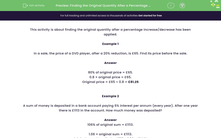This activity is about finding the original quantity after a percentage increase/decrease has been applied.
Example 1
In a sale, the price of a DVD player, after a 20% reduction, is £65. Find its price before the sale.
Answer
80% of original price = £65.
Divide 80% by 100 to remove the percentage = 0.8
0.8 × original price = £65.
Original price = £65 ÷ 0.8 = £81.25

Example 2
A sum of money is deposited in a bank account paying 6% interest per annum (every year). After one year there is £1,113 in the account. How much money was deposited?
Answer
106% of original sum = £1,113.
Divide 106% by 100 to remove the percentage = 1.06
1.06 × original sum = £1,113.
Original sum deposited = £1,113 ÷ 1.06 = £1,050
ALWAYS CHECK that the sale price is less than the original and that an increased quantity is more than the original!

In this activity, don't put any units in your answer.
If the question is about money, remember to give your answer to 2 decimal places - that is pounds and pence - unless it is a whole number.
Let's get started!








